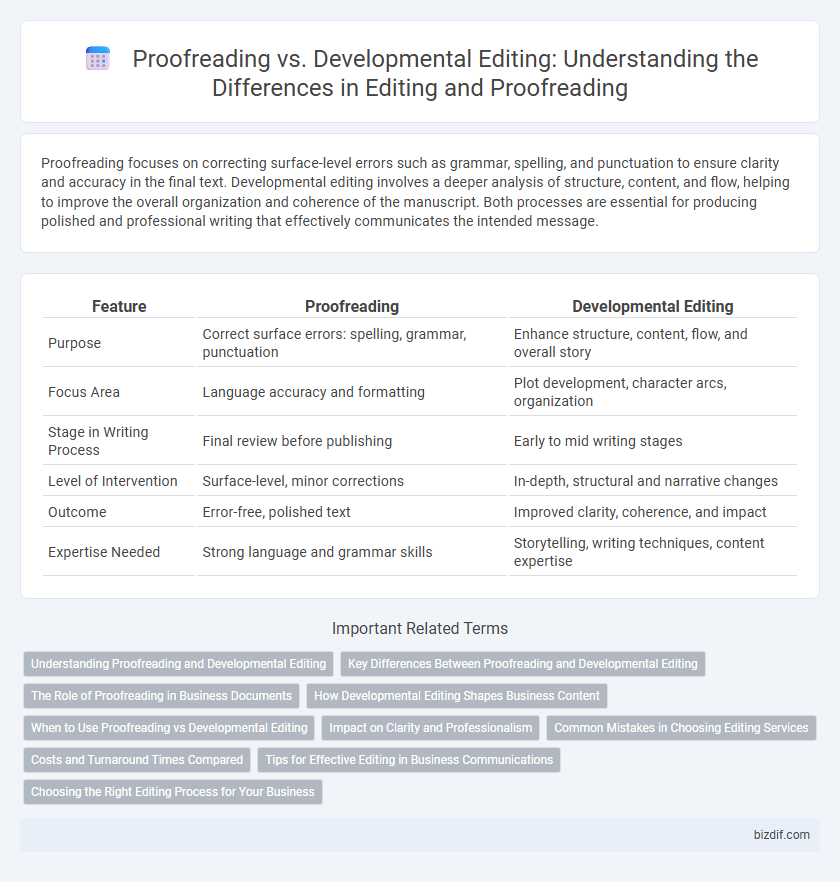Proofreading focuses on correcting surface-level errors such as grammar, spelling, and punctuation to ensure clarity and accuracy in the final text. Developmental editing involves a deeper analysis of structure, content, and flow, helping to improve the overall organization and coherence of the manuscript. Both processes are essential for producing polished and professional writing that effectively communicates the intended message.
Table of Comparison
| Feature | Proofreading | Developmental Editing |
|---|---|---|
| Purpose | Correct surface errors: spelling, grammar, punctuation | Enhance structure, content, flow, and overall story |
| Focus Area | Language accuracy and formatting | Plot development, character arcs, organization |
| Stage in Writing Process | Final review before publishing | Early to mid writing stages |
| Level of Intervention | Surface-level, minor corrections | In-depth, structural and narrative changes |
| Outcome | Error-free, polished text | Improved clarity, coherence, and impact |
| Expertise Needed | Strong language and grammar skills | Storytelling, writing techniques, content expertise |
Understanding Proofreading and Developmental Editing
Proofreading involves meticulously reviewing text to identify and correct surface errors such as grammar, spelling, punctuation, and formatting inconsistencies. Developmental editing focuses on the overall structure, content, and flow of a manuscript, addressing plot development, character arcs, and thematic coherence. Understanding the distinction between these processes is essential for selecting the appropriate service to enhance the clarity and impact of a written work.
Key Differences Between Proofreading and Developmental Editing
Proofreading involves correcting surface-level errors such as grammar, spelling, punctuation, and formatting inconsistencies to ensure text accuracy. Developmental editing addresses the manuscript's overall structure, content clarity, plot coherence, and character development to enhance narrative flow and thematic consistency. The key difference lies in proofreading's focus on final polish, while developmental editing targets substantial content revision and improvement.
The Role of Proofreading in Business Documents
Proofreading in business documents ensures accuracy by eliminating typographical, grammatical, and formatting errors that could undermine professional credibility. It plays a critical role in maintaining clarity and consistency, which enhances effective communication with clients, stakeholders, and partners. Unlike developmental editing, which focuses on content structure and flow, proofreading is the final quality control step that guarantees polished and error-free business communications.
How Developmental Editing Shapes Business Content
Developmental editing shapes business content by refining the structure, clarity, and overall messaging to align with strategic goals and target audiences. It involves analyzing content flow, coherence, and the effectiveness of key arguments to ensure the business narrative drives engagement and conversions. Unlike proofreading, which corrects grammar and punctuation, developmental editing transforms raw drafts into compelling, purpose-driven materials.
When to Use Proofreading vs Developmental Editing
Proofreading is ideal for the final stage of the writing process, focusing on correcting surface errors such as grammar, punctuation, and spelling. Developmental editing is essential early on, addressing structural issues, plot development, and overall content clarity. Writers should choose developmental editing when seeking to improve the manuscript's organization and flow, while proofreading is appropriate for polishing the text before publication.
Impact on Clarity and Professionalism
Proofreading ensures clarity and professionalism by eliminating grammatical errors, typos, and inconsistencies that can distract readers and undermine credibility. Developmental editing enhances clarity by restructuring content, improving flow, and refining the overall message to strengthen the document's impact. Together, these processes elevate the text's readability and present a polished, authoritative final product.
Common Mistakes in Choosing Editing Services
Common mistakes in choosing editing services include confusing proofreading with developmental editing, leading to inadequate revisions for manuscript structure or content depth. Proofreading focuses on surface errors like grammar, spelling, and punctuation, while developmental editing addresses organization, plot, and character development, requiring different expertise. Selecting the wrong service can result in unresolved narrative issues or overlooked typographical errors, impacting the manuscript's overall quality.
Costs and Turnaround Times Compared
Proofreading typically costs less than developmental editing, with rates ranging from $0.01 to $0.03 per word compared to $0.03 to $0.08 per word for developmental editing. Turnaround times for proofreading are faster, often completed within 24 to 72 hours, while developmental editing can take several weeks depending on manuscript length and complexity. The cost and time differences reflect the scope of each service, as proofreading focuses on surface errors and developmental editing involves comprehensive content restructuring.
Tips for Effective Editing in Business Communications
Proofreading ensures error-free business communications by focusing on grammar, spelling, and punctuation, while developmental editing refines structure, clarity, and content flow for strategic messaging. Effective editing tips include reading aloud to catch inconsistencies, using editing tools like Grammarly for accuracy, and maintaining a clear, concise tone aligned with the brand voice. Prioritizing audience understanding and consistency enhances professionalism and communication impact in corporate documents.
Choosing the Right Editing Process for Your Business
Proofreading focuses on correcting surface errors like grammar, punctuation, and spelling to ensure polished final content. Developmental editing involves restructuring and refining the overall content, flow, and style to enhance clarity and effectiveness. Choosing the right editing process depends on your business goals: opt for proofreading to finalize error-free documents or select developmental editing to improve content quality and reader engagement.
Proofreading vs Developmental Editing Infographic

 bizdif.com
bizdif.com